Shopping centers, restaurants, business buildings, etc., must manage their wastewater effectively to maintain the septic system in good condition. Regular maintenance is necessary to prevent expensive repairs and ensure optimal system performance.
In this article, we will discuss the most common issues that commercial septic systems have, and we’ll provide some practical solutions to fix them.
What Are The Signs of Commercial Septic Issues
To avoid any problems with the septic system, it’s important to be on the lookout for certain warning signs.
These may include:
- High Water Bills: Elevated bills could signify malfunctioning or leaking components within the septic system.
Immediate Action: Schedule a professional inspection to identify and address the source of the issue.
- Foul Odors: Unpleasant smells may point to sludge buildup or a potential blockage in the system.
- Immediate Action: Professional intervention is crucial to promptly identify and remedy the root cause.
- Backups: Frequent backups often result from blockages, clogs, or other tank or drain field complications.
Immediate Action: Promptly address blockages and enlist professional help for a thorough system inspection.
- Slow Drainage: This can indicate issues with pipes or a gradual accumulation of sludge and debris.
Immediate Action: A professional inspection will be performed to diagnose and resolve the drainage issue promptly.
What Are The Causes of Commercial Septic Issues
To effectively address commercial septic problems, it’s crucial to comprehend their root causes.
Common contributors include:
- Overloading the System: Excessive wastewater exceeding the system’s capacity can lead to slow draining, backups, and system failure.
Preventive Measure: Monitor and regulate wastewater discharge to avoid overloading the system.
- Lack of Maintenance: Regular inspections, pumping, and cleaning are vital for preventing clogs, backups, and other septic system malfunctions.
Preventive Measure: Establish a routine maintenance schedule and adhere to it diligently.
- Aging Systems: Older septic systems may struggle to treat wastewater effectively, resulting in backups and unpleasant odors.
Preventive Measure: Consider system upgrades or replacements for aging septic systems.
- Flushing Wrong Items: Inappropriate items like paper towels, grease, and feminine hygiene products can clog your septic system.
Preventive Measure: Educate users on proper waste disposal practices to prevent blockages.
- Tree Roots: Invasive tree roots can damage septic pipes and tanks, causing leaks and backups.
- Preventive Measure: Make sure to regularly check your septic system for tree roots that may be growing too close. If you find any, take care of them promptly.
How To Adress The Problems
If you have problems with your commercial septic system, it’s important to seek help from a professional technician. Trying to fix the problem alone can be dangerous and may worsen the situation.
Here are common issues and their professional solutions:
- Tank Problems: Damaged tanks may require replacement, and techniques like hydro jetting can be employed to clean the tank and remove blockages.
Professional Solution: Consult a septic system service provider for an accurate assessment and necessary interventions.
- Drain Field Problems: Clogged drain fields may need excavation and removal of obstructing materials.
Professional Solution: Engage professionals for thorough excavation and drain field restoration.
- Clogs and Backups: Professionals use Specialized tools to clear clogs and blockages.
Professional Solution: Rely on professional expertise to efficiently clear blockages and implement preventive measures.
- System Maintenance: Regular inspections, pumping, and cleaning by professionals can prevent future issues and maintain system functionality.
- Professional Solution: Schedule a routine maintenance with a proffessional septic system service provider.
Businesses must keep their septic systems in good condition to operate smoothly. Regular maintenance and timely professional check-ups are necessary to prevent costly repairs and to ensure the well-being of employees and customers.
Discover more from Futurist Architecture
Subscribe to get the latest posts sent to your email.




